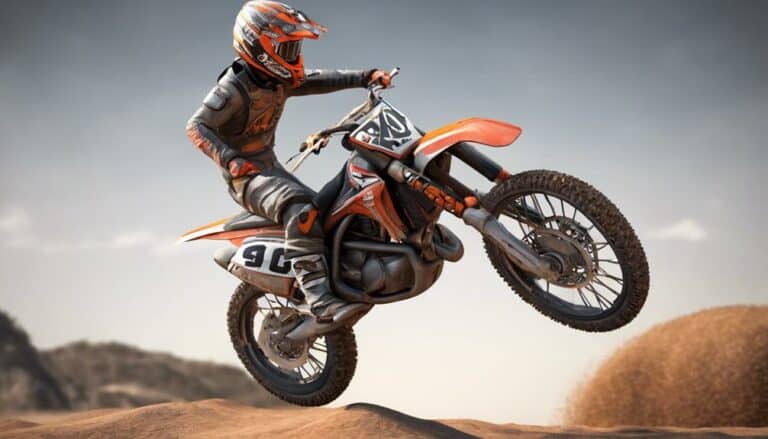When preparing for a dirt bike jump, think of it as a dance between you and the terrain, a harmonious blend of skill and precision. As you gear up for that exhilarating moment of lift-off, there are key elements to contemplate:
- Evaluating the jump conditions
- Mastering body positioning techniques
- Throttle control
However, there's one vital factor that can make or break your jump, a secret ingredient that often gets overlooked but plays a significant role in your success.
Intrigued to find out what it is? Keep reading to uncover the best practices for mastering the art of dirt bike jumping.
Key Takeaways
- Evaluate jump conditions for height, speed, and obstacles.
- Maintain proper body positioning with a 45-degree angle.
- Master throttle control and speed management techniques.
- Practice landing preparation and recovery for smooth landings.
Assessing Jump Conditions
Before approaching any dirt bike jump, carefully assess the jump conditions to guarantee a safe and successful ride. Start by evaluating the jump's height to determine the speed and power needed for take-off.
Next, check the run-in area for any obstacles or bumps that could affect your approach. Assess the terrain consistency to make sure a stable landing surface, reducing the risk of accidents. Consider the wind direction and speed as they can impact your trajectory mid-air.
Determine the jump face angle to position your bike correctly for both take-off and landing. In conclusion, assess the landing area to anticipate how to smoothly touch down.
Body Positioning Techniques
Evaluating the jump conditions thoroughly sets the stage for implementing effective body positioning techniques during your dirt bike jump. To achieve best stability and control in the air and upon landing, consider the following body positioning techniques:
- Maintain a 45-degree angle with your upper body and hips to enhance balance and control throughout the jump.
- Keep your knees squeezing the bike and feet forward to promote stability and control in the air.
- Stand instead of sitting on the bike while preparing to jump to guarantee better weight distribution and maneuverability.
- Hold a neutral position on the bike, neither too far forward nor back, to maintain balance during take-off and landing.
Throttle Control and Speed Management
To safeguard a stable and controlled dirt bike jump, masterful throttle control and speed management are essential components of your technique. Maintaining controlled throttle input is vital for achieving a smooth takeoff and landing. Choose a consistent speed that you're comfortable with to approach the jump, as this will help you maintain balance in the air.
Avoid sudden or aggressive throttle movements that could disrupt the bike's stability mid-air. It's important to synchronize your throttle control with your body positioning to guarantee a coordinated and controlled jump. Practice different throttle inputs to understand how they affect the bike's behavior during jumps.
Landing Preparation and Recovery
Guarantee your dirt bike landing readiness by mastering proper techniques to minimize impact and maintain control. When landing, it's crucial to focus on evenly distributing your weight on both tires to prevent the front end from dropping abruptly. Keep your body relaxed and in a neutral position, allowing you to smoothly absorb the impact of the landing. Just before touchdown, implement throttle control to keep your bike stable and maintain forward momentum. Practice on smaller jumps to hone your landing techniques before progressing to larger ones.
- Weight Distribution: Distribute your weight evenly on both tires to prevent the front end from dropping suddenly.
- Body Position: Keep your body relaxed and in a neutral position to absorb the landing smoothly.
- Throttle Control: Implement throttle right before landing to maintain control and stability.
- Practice on Small Jumps: Start with smaller jumps to perfect your landing techniques and avoid common pitfalls like looping, where the bike flips backward due to improper weight distribution.
Practice for Success
Mastering dirt bike jumps requires consistent practice, starting with smaller jumps and gradually progressing to larger ones to build confidence and enhance your skills effectively in a controlled environment. Begin by practicing on the smaller jumps to familiarize yourself with the takeoff and landing dynamics. Focus on perfecting your technique and body positioning during the first jump to establish a strong foundation. Building confidence through repetition is vital in dirt bike jumping; hence, repeat jumps on different terrains to adapt to various conditions and refine your skills.
To practice for success, create a controlled environment that mimics real jump scenarios. This setting allows you to concentrate on mastering each jump without external distractions. As you gain more experience and confidence, gradually increase the jump size to challenge yourself further. Remember, consistent and purposeful practice is the key to becoming proficient in jumping a dirt bike. By dedicating time to practice and pushing your limits in a safe and controlled manner, you can enhance your jumping abilities and achieve success in this thrilling sport.
Conclusion
As you soar through the air on your dirt bike, remember that mastering the art of jumping takes dedication and skill.
Like a skilled pilot steering through turbulence, you must maintain control and precision in the face of uncertainty.
Keep practicing, keep refining your techniques, and soon you'll be flying with the grace of a bird in flight.
Embrace the challenge, trust in your abilities, and let your passion for jumping propel you to new heights.

